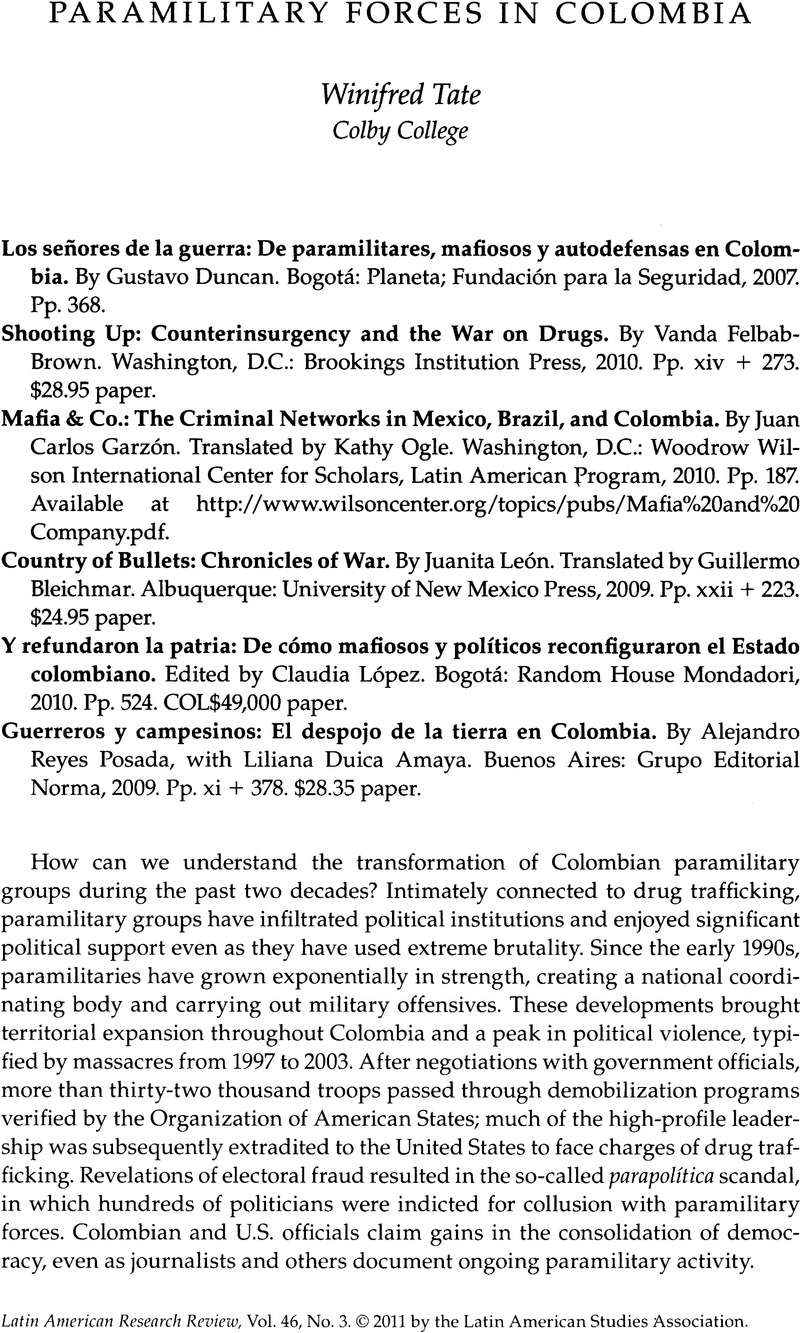Published online by Cambridge University Press: 05 September 2022

1. Carlos Medina Gallego wrote one of the few studies of the origins of regional paramilitarism in Colombia in Autodefensas, paramilitares y narcotráfico en Colombia: Origen, desarrollo y consolidación: el caso “Puerto Boy acá” (Bogotá: Editorial Documentos Periodísticos, 1990); another early analysis is Francisco Cubides, “Los paramilitares y su estrategia,” in Reconocer la guerra para construir la paz, ed. María Victoria Llórente and Malcolm Deas (Bogotá: Grupo Editoral Norma, 1999), 151–199. Several Web sites provide ongoing current analysis, including Verdad Abierta (http://www.verdadabierta.com), focused on paramilitaries and armed conflict in Colombia, and InSight (http://www.insightcrime.org), on organized crime in the Americas.
2. Francisco Thoumi, “The Numbers Game: Let's All Guess the Size of the Illegal Drug Industry!” Journal of Drug Issues 35, no. 1 (2005): 185–200; Peter Andreas, “The Politics of Measuring Illicit Flows and Policy Effectiveness,” in Sex, Drugs and Body Counts: The Politics of Numbers in Global Crime and Conflict, ed. Peter Andreas and Kelly M. Greenhill (Ithaca, NY: Cornell University Press, 2010), 23–45; Winifred Tate, “Accounting for Absence: The Colombian Paramilitaries in U.S. Policy Debates,” in Sex, Drugs and Body Counts: The Politics of Numbers in Global Crime and Conflict, ed. Peter Andreas and Kelly M. Greenhill (Ithaca, NY: Cornell University Press, 2010), 215–246.
3. Mauricio Romero, Paramilitares y autodefensas, 1982–2003 (Bogotá: Instituto de Estudios Políticos y Relaciones Internacionales, 2003); Mauricio Romero, ed., Parapolítica: La ruta de la expansión paramilitar y los acuerdos políticos, 2nd ed. (Bogotá: Corporación Nuevo Arco Iris, 2007).
4. Julie Mazzei develops a model of paramilitary groups emerging from the space between civil society and the state to defend particular economic and political interests, but her consideration of Colombia does not adequately address the complexities of these relationships in Death Squads or Self Defense Forces? How Paramilitary Groups Emerge and Challenge Democracy in Latin America (Chapel Hill: University of North Carolina Press, 2009).
5. A summary of Garay's argument is available in English as “From State Capture towards the Co-opted State Reconfiguration: An Analytical Synthesis,” Método Working Paper No. 61 (2009), at http://papers.ssrn.com/sol3/papers.cfm?abstract_id=1410865.
6. Roy Godson, “The Political Criminal Nexus and Global Security,” in Menace to Society: Political-Criminal Collaboration around the World, ed. Roy Godson (New Brunswick, NJ: Transaction Publishers, 2003), 1–26.
7. For a troop-level analysis, see Kimberly Theidon, “Reconstructing Masculinities: The Disarmament, Demobilization, and Reintegration of Former Combatants in Colombia,” Human Rights Quarterly 31, no. 1 (2009): 1–34.
8. See Bettina Ng'weno, Turf Wars (Palo Alto, CA: Stanford University Press, 2007); Arturo Escobar, Territories of Difference (Durham, NC: Duke University Press, 2008).